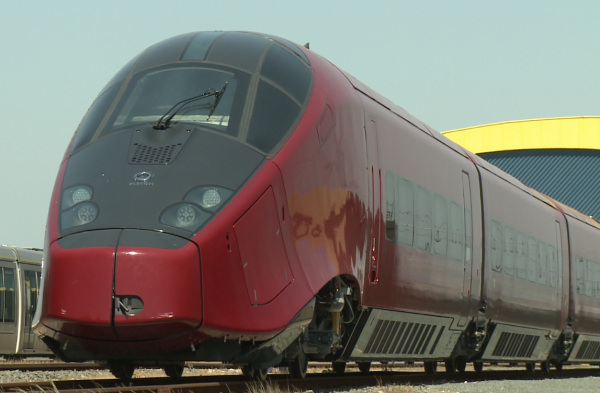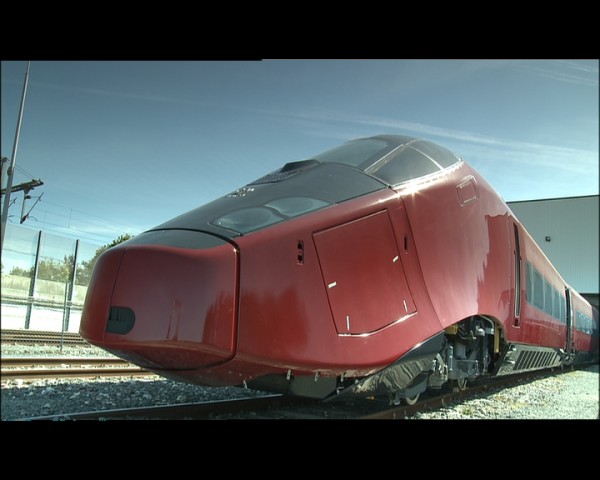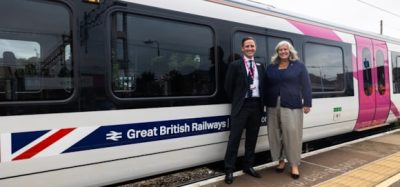The kick-off for Italo has been set
Posted: 3 August 2010 | | No comments yet
NTV, the first Italian private high-speed operator, will start commercial service in September 2011. We officially announced the kick-off date in a press conference we held in Rome at the end of May 2010. We therefore have 15 months of tough work ahead to complete the necessary steps to ultimate the preparation phase of our project.
It’s not easy, but we’re very excited by this fascinating challenge and we feel confident we’ll respect this strict time schedule. Or philosophy can be summarised by our brand new slogan, chosen by our Marketing Division: ‘Italo, il tuo treno’ (‘Italo, your train’). With this claim we’d like to underline that Italo is conceived for the needs of every kind of traveller. The slogan is also the welcome message of the new NTV site (www.ntvspa.it). But to keep this promise we have to work hard every day on each field we’re engaged in.
NTV, the first Italian private high-speed operator, will start commercial service in September 2011. We officially announced the kick-off date in a press conference we held in Rome at the end of May 2010. We therefore have 15 months of tough work ahead to complete the necessary steps to ultimate the preparation phase of our project. It’s not easy, but we’re very excited by this fascinating challenge and we feel confident we’ll respect this strict time schedule. Or philosophy can be summarised by our brand new slogan, chosen by our Marketing Division: ‘Italo, il tuo treno’ (‘Italo, your train’). With this claim we’d like to underline that Italo is conceived for the needs of every kind of traveller. The slogan is also the welcome message of the new NTV site (www.ntvspa.it). But to keep this promise we have to work hard every day on each field we’re engaged in.
NTV, the first Italian private high-speed operator, will start commercial service in September 2011. We officially announced the kick-off date in a press conference we held in Rome at the end of May 2010. We therefore have 15 months of tough work ahead to complete the necessary steps to ultimate the preparation phase of our project.
It’s not easy, but we’re very excited by this fascinating challenge and we feel confident we’ll respect this strict time schedule. Or philosophy can be summarised by our brand new slogan, chosen by our Marketing Division: ‘Italo, il tuo treno’ (‘Italo, your train’). With this claim we’d like to underline that Italo is conceived for the needs of every kind of traveller. The slogan is also the welcome message of the new NTV site (www.ntvspa.it). But to keep this promise we have to work hard every day on each field we’re engaged in.
Rolling stock type
Let’s start with the train construction, which is obviously, one of the key areas of our project. The construction is proceeding as planned. On 10 May 2010, the first train of our fleet came out in its definitive configuration (11 coaches, 200m-long with red livery) from the Alstom factory in La Rochelle. It was a touching and historical moment for us. The train will now be subjected to a series of technical tests. NTV has purchased 25 AGV-model high-speed trains from Alstom, which are under construction in the Savigliano (Cuneo province) and La Rochelle plants. The AGVs are trains of the very latest technological conception and NTV will be the first operator in the world to use this type of train, which assures exceptional performance in speed, comfort, respect for the environment and safety. But building the trains is only one aspect of the project. We need facilities in the stations and well organised staff on the territory.
Stations
Our Italo train service will reach nine Italian cities and 12 stations, among which all those dedicated to high-speed. In particular, Italo will stop in Turin (Porta Susa Station), Milan (Porta Garibaldi and Rogoredo stations), Bologna (Central Station), Florence (Santa Maria Novella Station), Rome (Tiburtina and Ostiense stations), Naples (Central Station), Salerno (Central Station), Venice (Santa Lucia and Mestre stations) and Padua (Central Station). In every station, NTV will present its offer through a ‘Casa Italo’, a true services centre in which travelers, assisted by NTV personnel, can purchase tickets and get information about Italo services. The design of the various ‘Case’ was assigned to Boeri, one of the most famous Italian Architecture Studios, which is creating spaces under the ensign of functionality and style, conceived for travellers’ needs. The areas dedicated to the Casa Italo have already been identified with the managing companies of the major stations, Grandi Stazioni and Cento Stazioni, and works for their construction will begin shortly. The Italo service will be operating on the Turin–Milan–Bologna–Florence– Rome–Naples–Salerno line and on the Venice–Padua–Bologna–Florence–Rome line, covering entirely the new Italian high-speed infrastructure. Every day, 51 trips will be made on a total of 12.3 million kilometers per year: in particular, 41 trips will be made on the Turin–Salerno main line and 10 trips on the Venice–Rome–Naples line.


NTV, Italy’s first private high-speed operator, will operate the Italo
Tests
In the meanwhile, we’re already working together with Alstom on the homologation process of the train. A prototype of our train has been travelling on the Italian lines since early 2010 to undergo validation test. After reaching the speeds of 300km/h in March 2010, the Italo prototype train is now undergoing tests of the signalling system. During this phase, particular tests are being carried out on maximum traction and braking to validate the signalling system under extreme conditions, along with checks on the reception of signals coming from ground and tests on ground/on-board radio connections. The train has already covered 15,000km in Italy, after travelling for more than 50,000km in France.
The Nola Maintenance Depot
At the same time, we’re working on our Nola Maintenance Depot. The first phase of the works for the construction of the infrastructure, in the Nola Campano Interport (close to Naples), has been completed. All the plant’s foundation works have been finished, as have been the structures of the eight main buildings. For the construction of the infrastructure (140,000m2) devoted to maintenance of the Italo fleet, NTV has invested €90 million. On the completion of the Depot, expected by May 2011, there will be some 30,000m2 of roofed area with an annexed 55,000m2 of area outfitted with tracks. The area will be completed with infrastructures, service buildings and two large storage buildings crossed by tracks for short and long-route maintenance. There will also be an area of 3,500m2 with an annexed pair of tracks and loading dock outfitted for carrying on activities such as washing, toilet sanitising and train inspections.
Staff
Another key factor for the success of our project is the staff. For both on-board and ground personnel the company is launching a new hiring campaign to fill 850 positions. Of these, 90% are reserved for people under the age of 35 (60% of the total for the under 30s). We are recruiting for hostesses, stewards, train managers, train specialists, managers responsible for crews and travellers, and assistance personnel for the Casa Italo centres. NTV will invest €17.5 million for its Training School, where the first hundred Italo engineers are being trained, divided into four Student Courses composed of trainees with an average age of 25. In 2013, there will be an overall NTV staff figure of more than 900 employees, 80 of which for the Rome central headquarters and the rest assigned to operating jobs: railroad engineers, railway workers, and coordination and assistance personnel. Noteworthy too is the indirect employment generated by NTV, which can be estimated at 700 people. For train cleaning, some 200-220 people will be employed, while it is calculated that 200 specialised workmen will be providing maintenance of the Italos. For on-board dining, another 200-220 people will be needed. Finally, the NTV Contact Centre will employ 80 workers.
On-board entertainment
During our press conference, we revealed some unique features of our train that prove the effort we’re making to improve travel time when you’re on board. Italo is equipped with a unique system that offers travellers the highest standards of connections and entertainment on-board. The technological solution adopted consists in a communications infrastructure based on the combination of three technologies (satellite, UMTS and Wi-Fi) which provides for various levels of use by passengers: from internet connection on one’s own PC or hand-held device up to the enjoyment of entertainment, including TV on the on-board portal. Italo also has a Cinema Coach available for those wishing to relax with a programme of entertainment that includes first-run films. The Italo is one of the world’s first applications of two-way satellite communication with wide-band connections that enables passengers to make the best of their travel time. Besides the satellite, the connection for internet navigation takes advantage of the UMTS telephone network and of the Wi-Fi network too. The result of the interplay between these three systems assures an internet navigation experience that is always of high quality in terms of speed and continuity, even at 300km/h. The interaction of these three technologies enables the highest degree of coverage even on the most demanding routes, such as those with a large number of tunnels or other obstacles.
For on-board entertainment, Italo makes a train portal available to passengers from which it will be possible to gain access to entertainment with absolutely innovatory characteristics in the world’s technology scenario, thanks to the quality of the content and the satellite television channel. The on-board portal is accessible from travellers’ personal computers or hand-held devices through intranet connection at high-speed and has a capacity of more than 250 hours of high-definition video and more than 250 hours of audio. The connection system is able to transmit a TV channel providing news and entertainment. The programming may be dedicated, depending on the occasions, to live events of particular interest. In an on-board ambience, there will also be individual touch screens from which one can navigate through the entertainment menu, including television channels.


The Italo train is built with 98% of recyclable material
Environmental sustainability
Eco-design of Italo
The Alstom AGV model, the technology base of Italo, is the result of a process of eco-design aimed at reducing its impact, in terms of pollution, throughout the operating life of the train, from the initial stage of production to the final stage of recycling. The train is 98% built with recyclable materials, such as aluminium, steel, copper and glass.
Furthermore, the use during every phase of the train’s construction of materials resistant to deterioration gives Italo an operating life 15% longer than other trains, meaning one of more than 30 years.
In line with sustainable development
Thanks to the use of composite materials, the more effective traction systems and the extended architectural configuration, Italo is roughly 70 tonnes lighter than the trains manufactured by the competition, making for a 15% reduction in energy consumption compared to a traditional train with equal performance levels. As a result, Italo emits extremely low levels of greenhouse gases (CO2), quantified at only 2.2g/km/passenger, a level 13 times lower than a bus (30g) and 70 times lower than an airplane (153g). This means annual energy savings of approximately 650,000 kWh over an operating distance of 500,000km.
Italo also produces its own electricity, thanks to a system that combines a rheostat brake with an energy-recovery brake. While the train is slowing down, up to 8 MW of unused electricity is returned to the power-supply network.
Minimal noise pollution
Reduced noise, both inside and outside, is another advantage of the eco-design of Italo. The positioning of the bogies (located between the bodywork and not under the passenger cars), as well as the aerodynamic design, the addition of air deflectors, the use of aero-acoustic dampers, the insulation materials and the improvement in the wheel/rail contact, are some of the innovations in the field of aero-acoustics that will allow NTV’s future trains to travel at increasingly lower levels of noise.
Meeting the objective
We’ll reveal the train interiors and our marketing strategies in a future press event. The interiors are being built by Italdesign–Giugiaro, one of the leaders of Italian design. Our objective is to have top quality for all passengers with flexible prices and different levels of service. September 2011 is very close and we’re looking forward to beginning our service. We think NTV can contribute in making the train more and more popular among travellers with important benefits for the environment and for the development of the Italian transportation system.
About the Author
Giuseppe Sciarrone
Giuseppe Sciarrone graduated from Milan Polytechnic in 1970 with a degree in Mechanical Engineering and a specialisation in the technology and economics of transportation. For more than 35 years, Mr. Sciarrone has gained experience in different transport-related posts including the Coordinator of the Technical Office of the Inter-Ministerial Committee for the Economic Planning of Transport (CIPET). Mr. Sciarrone is a founding shareholder of NTV which was established in December 2006.
Issue
Related topics
High-Speed Rail, Rolling Stock Orders/Developments, Station Developments








